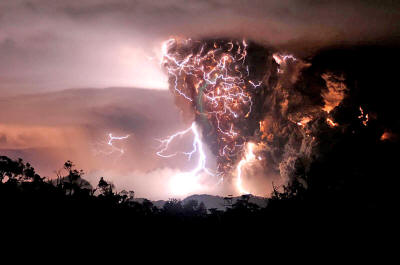|
by Stephen Smith from Thunderbolts Website
Lightning erupts from
the crater of Mount Shinmoedake on the island of Kyushu in Japan.
Lightning discharges in the atmosphere
are familiar, but what about the ones underground?
Earth's gravity then pulls it back to the surface where the
cycle repeats.
As the droplets that
have lost an electron continue to rise, they carry a positive charge
into the top of the cloud.
Gigantic branching displays were photographed during the Mt. Chaiten eruption in May of 2008 (below image).
There were reports of ball lightning bigger than beach balls rolling along the ground when Mt. St. Helens erupted in 1980.
Eyjafjallajökull
produced flashes that lit up the sky for many kilometers (below
video).
Thousands of amperes flow beneath the
surface, varying according to conductivity. Since
the Sun can affect
Earth's magnetic field through geomagnetic storms, fluctuations in
telluric currents can occur when there is an increase in sunspots or
solar flares, because they create oscillations in the ionosphere.
Ball lightning has been reported accompanying earthquakes, as have bright, colorful cloud-like formations floating in the sky above the fractured strata. It is not surprising that glow discharges occur before and after earthquakes: compressing quartz creates a flow of electric current. That is one reason why radio noise can be detected coming from areas under extreme stress.
Is that stress only due to compression?
Electric charge on one plate attracts an opposite charge to the other, resulting in an electric field between them.
As the capacitor's charge increases, its
electric field increases, stressing the insulator's ability to
separate opposite charges. If a high enough potential grows between
the two conductive plates, the dielectric insulator will fail and
the capacitor will short circuit, suddenly releasing the stored
energy.
When the two lightning leaders meet, a
circuit between the clouds and the ground (or between one cloud and
another) is completed and a burst of electric current flashes along
the conductive pathway.
Electromagnetic forces between current filaments and between double layers can cause sudden pressure variations. If, as stated above, the charge differential between layers becomes too great, a double layer can explode, releasing all of its energy flow instantaneously.
So, earthquakes can be considered a form of
underground lightning. If there is a break in the strata, permitting
magma to reach the surface, the arc discharge might connect to the
outside and a lightning bolt will leap from the cone of a volcano.
In that case, it seems likely that the
majority of energy release during an earthquake is not from the
fracturing and movement of rock strata, but is the result of
electrical energy detonating within the matrix.
|


